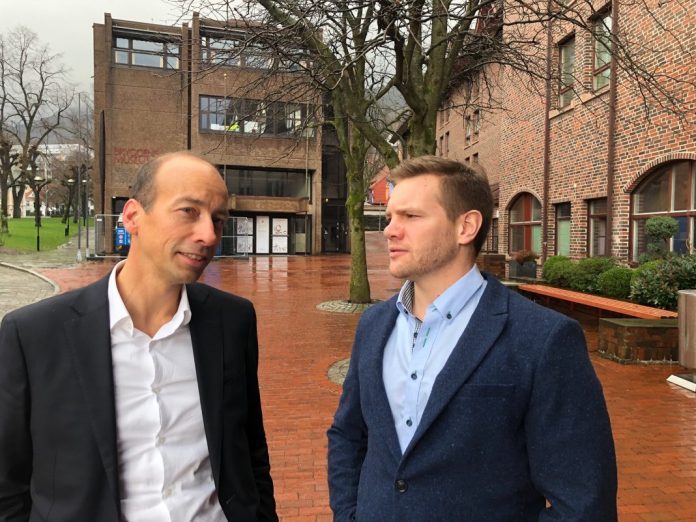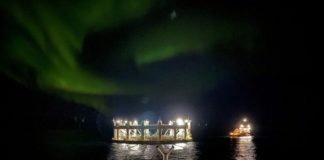Now the duo believe it is time for algae to be lifted in line with other recognised feed ingredients.
Dutch Corbion is a hundred-year-old company, founded for the production of sugar from sugar beet. Their main product is microalgae for the feed market. Corbion produces many products from sugar, and AlgaPrime is the flagship product for the fish feed market.
“Our largest algae product is AlgaPrime, an omega-3 rich product,” said Marc den Hartog to SalmonBusiness. He is Executive Vice President of Innovation Platforms in Corbion and is based in Amsterdam.
“A couple of years ago I was engaged in salmon farming. Besides AlgaPrime, we also have various feed ingredients in poultry production,” he explained.
350,000 tonnes
Corbion is a main supplier of algae feeds to the feed manufacturer BioMar.
“BioMar has produced approximately 350,000 tonnes of feed over the last two years containing AlgaPrime. Norway is the largest market for this, but we are also in Scotland, Chile, and other markets. We see good acceptance of the adoption of algae as a feed ingredient. We also provide to pets and poultry, but the great opportunity lies in salmon. And that is also why we entered this industry. We are an industrial scale manufacturer. We are not only here to make industry based on fermentation, but to build industry on a large scale,” he explained.
The production takes place in a distinctive process.
“We start with microalgae which is a natural raw material, and place them in large tanks for fermentation, where we feed them with cane sugar. Why? Because it is a raw material available, it is not genetically modified and is in line with other products in Corbion that are large sugar consumers,” said Hartog. “The algae consume the sugar and convert it into biomass and omega-3 rich oil. From there we dry it to a powder and then carry it in big bags into the feed factories.”
Industrial scale
The process is not different from nature’s own.
“The interesting thing about the algae is, it is not unique, in nature this is consumed by plankton and krill which are eaten by anchovies which in turn are consumed by wild salmon. We just skip the steps to find omega-3 in nature and feed it directly to the salmon. We have been producing AlgaPrime on an industrial scale since 2016,” he said.
“I come from the vegetable oil industry, and it was obvious to me to work with oils and fatty acids. It’s something I’m used to. This is pretty straightforward: you need to create a “jacuzzi” for the algae, you have to blow in a lot of air. The algae take the sugar molecules and use them as fuel to build cell structures, with lipids as the largest component,” Hartog continued.
In this way, they convert sugar into fat, not unlike what people do with every indulgant bite in December.
Excellent results
BioMar is very pleased with what they see from the algae protein.
“We use it in recipes with many other raw materials, and we see excellent results from AlgaPrime,” said BioMar’s Global Sustainability Specialist Erik Gracey.
Among the customers who have used the algae feed in fish feed are Lerøy Seafood Group and Kvarøy Fiskeoppd Liv.
“This is an answer to the shortage of omega-3 from fish oil. We believe algae provides a new food source for salmon without putting pressure on sea life. But we are not here to replace fish oil,” he stated.
Price premiums
Corbion sees no practical limitations on production. Sugar is not a real scarcity.
-The algae is traded with a price premium relative to fish oil. How big is this?
“We entered farming three years ago with large-scale production. It was a conscious choice to make AlgaPrime competitive in terms of price. The gap between fish oil and AlgaPrime is becoming smaller. We believe we can further reduce that gap so that more people can use this raw material,” said Hartog.
“AlgaPrime is not a gimmick. When a customer wants this product, we use it from one to five per-cent interference in the feed. If it wasn’t available on that scale, it won’t be relevant for BioMar,” Gracey said.
“It cannot be seen without the philosophy that the farmers have. BioMar is good at finding new diets for salmon,” Hartog chipped in.
Functionally
“The most important source of energy in the feed is vegetable oil. We look at algae as a functional raw material with an energy bonus,” Gracey continued.
Have you run blind tests on taste?
“We have produced a zero FIFO fish, and served concept fish with a high content of algae – and it tasted delicious,” said Gracey.
He rejects that the fish-eat-fish issue or that the salmon should be vegetarian is something for them.
“The goal of AlgaPrime is not to replace 100 per cent of the fish oil – it is a supplement. BioMar does not have a view on whether the salmon should be vegetarian or not. Our goal is to produce robust and healthy fish, which ends up as a preferred seafood product for our customers,” he explained.
-Given a significant increase in future demand, can you scale up production?
“Generally, CapEx plans take 12 months. We already have opportunities to offer it to the Norwegian market, if not the entire market,” said Hartog, adding that they have considerable spare capacity.
Among sugar plantations in Brazil
“Our large industrial scale factory is located in Brazil, a few hours from Sao Paolo. It is located in the middle of sugar plantations. We are in an area that is not associated with the discussion of deforestation, such as soy, which is produced further north,” he said.
The plant and the sugar plantations are also far from the Amazon rainforest.
“The same applies to the discussion on gene manipulation. The species we use is completely without gene manipulation. We have nothing to hide. We want to show how we produce this,” said Hartog.
Corbion has a turnover of about one billion euros annually and is listed on the Amsterdam Stock Exchange. It owns “about a dozen factories”.
“We are listed in the Netherlands, but we operate globally. I want to say we are a medium-sized company, with nearly 2,000 employees employed. We are big enough that one does not have to order their own pencils, but small enough to be flexible,” said Hartog.
Accessories
He is tired of seeing algae being placed in a segment for non-industrial feed ingredients.
“Something I’m surprised about; I see in interviews about “novel ingredients” where they say it becomes interesting to see how they will scale up. We have sold millions of kilos after three years. Together with BioMar we have a collaboration in fish feed, we sell products to supermarkets in the States. Let’s stop calling it “novel,” and rather call it one of the new tools in the toolbox. Algae has proven it, not just for salmon. But it can also help the salmon in several ways, including offering pigments,” he said.
-Is Corbion a biotech company?
“In this case, there is more industrial fermentation scale up, where we will develop it to its new potential. As a company, we use modern biotechnology in other segments, but in this context it is more upscale in nature in a new industrial setting,” he explained.
An innovation wave is rolling over the salmon farming sector. High salmon prices, as a function of production freezes, provide incentives for new thinking – financed by historically high cash flows. As is constantly being pointed out at current North Atlantic Seafood Conference, Norway is thus considered a techonology hub. An important part of the innovation is in fish feed.
“In general, I think the feed sector has a common goal of increasing the proportion of raw materials from lower trophic species, and raw materials that do not compete with human consumption feed sources, for instance by bacteria, insects and algae. BioMar and Corbion have shown that this can be a success with AlgaPrime, but the search will continue. Insects are an exciting development, but as I understand it produces only 6,000 tonnes of insect feed globally, and that’s not enough for a significant role provisionally,” said Gracey.
-How would you rate algae substances relative to, for example, krill?
“It is quite a different raw material, I feel it is wrong to compare it. Both are sourced from lower trophic raw materials, but they also have different properties so I feel it is wrong to compare them,” concluded Gracey.









